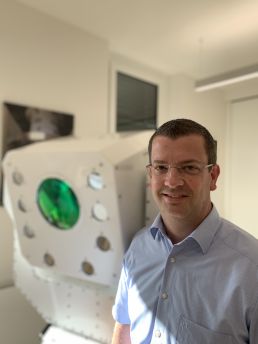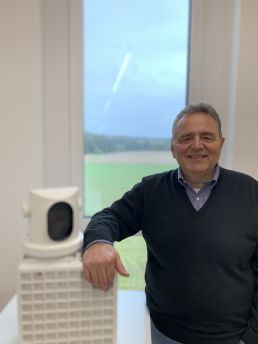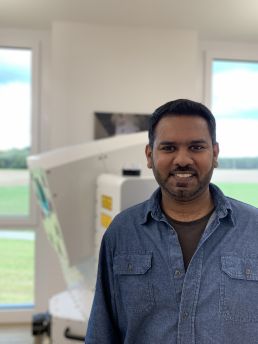In the hot seat with...
Sarina, Opto-Mechanical Design Engineer (top left), Stefan, Software Engineer (top right), Sandor, Electrical Engineer (bottom left) and Ahmad, Laser Communication Engineer (bottom right)
Can you tell us a little about your background please?
I come from the Stuttgart area originally but studied Aerospace Engineering at The University of Liverpool. From there I joined Safran Landing Systems in Gloucester but I was keen to focus on space activity so I moved to Airbus’s satellite facility in Hertfordshire. It was from Airbus that I joined Mynaric.
What made you join Mynaric?
I wanted to join a smaller company to broaden my skill set as a design engineer because here at Mynaric, I can start with a concept, work on that with colleagues, and see it through to the end. Rather than specialising, this working approach fosters my development as a well-rounded engineer due to the involvement in all steps of the product design cycle. It’s great to be able to speak with suppliers, see parts come in and actually get something made: from drawing board to actual production.
What do you like about working here?
You can run with ideas here. Even though you have your own targets and deadlines, if there is an area that interests you then there is no limit to explore it further. For example, I recently undertook some thermal analysis which was not strictly part of my job description but it gave me the opportunity to deepen my understanding of the interface between thermal and mechanical engineering and it was great to have the freedom to be able to do that.
And what exactly do you do here?
I am an opto-mechanical design engineer. I work with the optical engineers and make the design happen. As I work on a product that is destined for operation in space I have to ensure that all of the parts making their way into the product are able to function there: that means I have to ensure something can withstand the incredible differences in temperature that our products have to go through in space, the launch loads from the rocket and that they are durable enough for many years of operation.
And how is the atmosphere at Mynaric?
We have a very international team with people from different backgrounds and countries and that keeps things interesting! It is hugely enjoyable to work with a good, diverse mix of talented people.
I like the work I am doing here. The product we are making is very promising and the feedback we receive from customers in developing it shows how happy they are with it.
Anything else?
The area around where we are based is lovely. In one direction the lakes and the mountains and in the other the city – it’s great whether you want to spend time inside or outside!
Can you tell us a little about your background please?
I am originally from Augsburg – so a Bavarian! – and studied computer science. Following university, I spent 5 years at Siemens and 14 years at Rohde & Schwarz working on software development before joining Mynaric.
How did you end up joining Mynaric?
I felt that a smaller company would better suit my needs. I wanted a job in a company where I had much more hands-on development. Here at Mynaric I can really run with things; I feel I can really be in charge of changing things. At the bigger companies I worked for, when you had an idea that you wanted to introduce and take forward, you had to put a proposal together, take it to managers, try and persuade managers and then – usually – get a refusal! And that gets boring. But here at Mynaric it doesn’t get boring. I make a recommendation to my manager and am told to put a proposal together and run with it. I am given the green light to oversee an idea I know will benefit the company and oversee it from start to finish. I have introduced a lot of positive things here at Mynaric and that has been down to a manager who has allowed me to move forward with those ideas with support from him and from colleagues in the team.
What do you do here at Mynaric?
I build the software which controls all of the devices used by the laser communication terminals we make here. These are the embedded systems that go into these really complex products that operate in space and the stratosphere.
How do you find the working environment here at Mynaric?
I really like my colleagues here. I received a really warm welcome when I joined and my 20 years’ experience gained at larger companies was acknowledged and I was given a lot of respect by my new colleagues. And that really motivated me – and still does. The team here is open and accepting and there are never any arguments or egos: there is a really collegiate atmosphere and flexibility that really encourages us to participate as part of a great team.
And the area in which we work – how do you like that?
I live very close to the Ammersee so in my spare time, my family and I spend a lot of time taking part in water sports, especially sailing.
Can you tell us a little about your background please?
I studied at the Budapest University of Technology, graduating in 1983 – so I come to Mynaric with 30 years’ experience. I worked on hardware designs after graduating but gradually moved into programmable logic and then focused more and more on FPGAs (field-programmable gate arrays) and, specifically, on FPGA designs. At this time I was working mainly on medical imaging developments.
Just before coming to Germany I worked at Mentor Graphics for 5 years, the company that has been shaping the ways and methods concerning IC, FPGA and electronic designs. Those years gave me a wide range of technical and international experience and it was also a great place to work.
When I did move to Germany in 2011, I joined CommScope, the communication networks specialist and worked on wireless networking systems.
In 2017, I joined Mynaric.
And what do you do here at Mynaric
I work on FPGA designs here. The FPGAs, which have transformed over the years from something that was moderately complicated to something that is – today – hugely complex, are pretty core digital system components of the lasercom products we are making.
What do you particularly like about working here?
I enjoy working on a key module of the products we are producing – that is always good! I appreciate that Mynaric values my experience. Given 30 years’ experience working in my area of expertise, I can really call on a wide spectrum of knowledge and help contribute toward developments here.
And how do you relax outside of Mynaric?
I have a nice collection of classic toy trains: these are mostly of European origin but I also have some interesting pieces from the States.
I also enjoy Bavaria’s cultural heritage: museums, exhibitions and its artistic history as an area that was a base for several famous artists such as Kandinsky and Der Blaue Reiter group.
Can you tell us something about yourself that nobody knows?
I played a small part in the Rosetta project (the ESA project to land on comet 67P/Churyumov–Gerasimenko) in the late 1990s/early-2000s when I designed two FPGAs for the Philæ lander.
Can you tell us about your background please?
I am originally from Pakistan. Being an aviation enthusiast, I studied for my Bachelor of Engineering in Avionics with majors in Electronics and Telecommunications. I then spent 18 months working in Optics and Photonics and that is when I realized that this was an area that I really wanted to specialize in.
Having decided on a career in free-space optical communication (FSOC) I moved to Germany – to the Karlsruhe Institute of Technology – and completed an MSc on the subject with a full 2 years scholarship.
In 2013, I joined the German Aerospace Center’s (DLR) Institute for Communications and Navigation where I focused on FSOC between geostationary satellites and the ground. We were working on projects related to design, simulation and experiments on the said technology.
How did you come to join Mynaric?
Being a spin-off from the DLR, I was aware of Mynaric from the start and it was an obvious choice for me as I wanted to carry my technological background and merge it with a more commercial focus.
I sent off an unsolicited application and was asked in for an interview and here I am!
What is your role here at Mynaric?
I am an optical communications engineer, part of systems engineering. I work on generating the high-speed optical signal that is sent from satellite to satellite and then how that optical signal is converted back into data, both reliably and efficiently. In technical terms, my focus is on the physical layer of the Open System Interconnection model.
What do you like about working here?
Mynaric is commercializing laser communication and I believe that is a real game changer. The potential benefits – for the world not only Mynaric – are huge: an end to the digital divide, products that can help in areas affected by natural disasters – I am working on a product, and within a team, that can achieve all of these things. To be contributing to a product that could change the world and make people’s lives better is really important to me.
That I can use my skills and knowledge to work on something so important is very motivating for me and personally very satisfying. At Mynaric I am making things happen.
It is also great to have a very multicultural team here. People from different backgrounds and cultures have different ways of approaching problems and that makes for a great working environment and culture.
And how do you relax outside of Mynaric?
I have been skydiving for 4 years now and, in that time, made 140 ‘drops’. I have skydived all over Germany from Ulm to the Allgäu to Baden-Wuerttemberg.
I also love swimming in the lakes and swimming pools around Munich and spend the winter trying to improve my ice skating!



